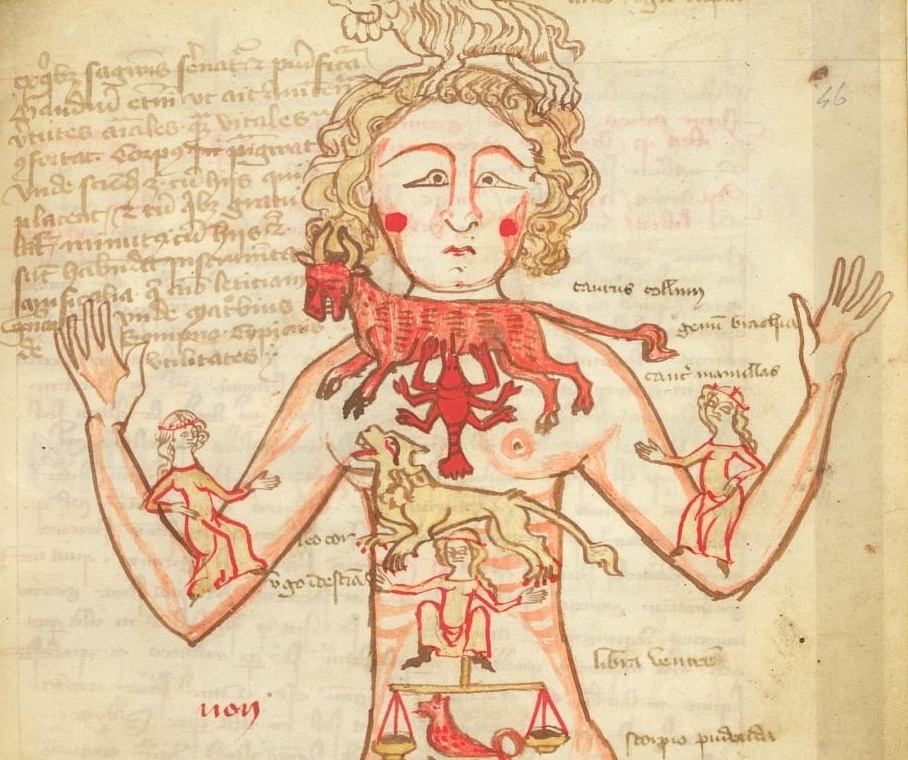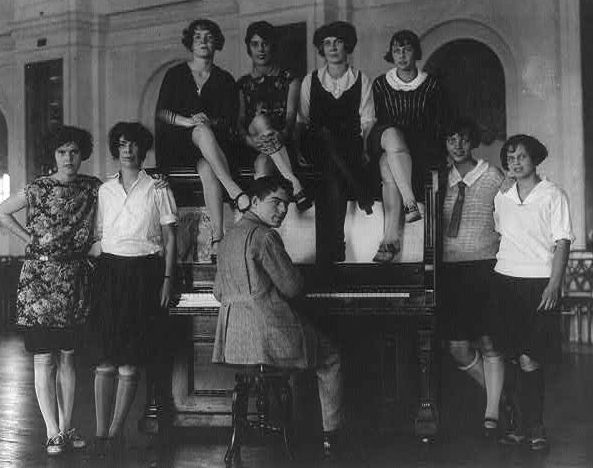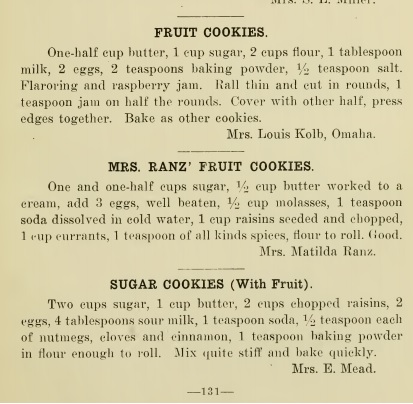The Zodiac Man or Man of Signs (homo signorum in Latin) is an age-old diagram relating the calendar and the movement of the heavenly bodies to the human body. Sections of the body are labeled with the twelve zodiacal signs, beginning with Aries, which ruled the head, and ending with Pisces associated with the feet. This illustration demonstrates centuries of connections between astrology and human personality, health, sickness, and medical treatments. For example, Leo is associated with the heart because tradition says the strength the lion was located in its heart. Scorpio is associated with the genitals because a scorpion’s strength was located in its tail.
Health care decisions were made using the Zodiac Man and calendars charting when the moon passed through the region of the heavens governed by the twelve signs of the zodiac. Each of the twelve signs of the zodiac occupies 30° of celestial longitude and roughly corresponds to the constellation after which it is named. For example, the presence and phase of the moon in a particular sign indicated an auspicious or risky day to bleed the part of the body governed by that sign. While some of these diagrams were accompanied by a basic explanation of the associations between the body and the heavens, most did not, assuming these astrological theories governing health care were widely accepted and understood.
Select the images for a larger view and more information.
Some images were accompanied by a poem such as this example from an 18th-century Virginia almanac:

The Ram possesseth head and face
The neck the Bull commands,
The loving Twins, with equal power, Guide shoulders, arms, and hands.
The breast and stomach Cancer owns,
The heart the Lion claims,
The Virgin loves the belly piece,
To Libra loins and reins.
The Scorpion has the secret part,
The thighs to Sagittarius,
To Capricorn we give the knees,
The legs unto Aquarius.
Now none but Pisces wants a share, To him we give the feet,
Then Aries head and face again, And so make both ends meet. (quoted in Horrocks, Popular Print and Popular Medicine, p. 28)
The Zodiac Man symbolized long-held beliefs that the moon, planets, and stars influenced the human body and personality. Humans, plants, animals, and seasons were all related to signs of the zodiac and were all thought to have similar characteristics of the zodiac to which they were linked.
Today, we call this astrology, a pursuit often considered a pseudoscience. However, for centuries, astrology and astronomy were two parts of the science the stars and the terms were often used interchangeably. Astronomy focused on calculating the motion of the planets and stars. Astrology interpreted the impact of the movements of the heavens on the natural world and society.

The notion that the earth mirrored the heavens and images of the Zodiac Man originated in ancient Near Eastern and Egyptian cultures and the theories were adopted by the Greeks and Romans. These beliefs continued to be prominent throughout western culture in the Middle Ages. The earliest known surviving diagram of the Zodiac Man is from the eleventh century. The images became increasingly common in thirteenth- and fourteenth-century manuscripts. Various Zodiac Man diagrams appeared in calendars, devotional books and treatises on philosophy, astrology, and medicine in the Middle Ages
The earliest representation of Zodiac Man in an almanac dates to the 13th century. Almanacs are books of charts and tables with a calendar, astrological and meteorological forecasts, and a variety of other information. After the advent of printing in the 15th century, the Zodiac Man diagram and associated information was a standard part of most almanacs.
The Zodiac Man and astrology in historical health care
The Zodiac Man represents centuries of belief by both educated elite and average people in the “science” of astrology and its impact on the health of humans. Medical treatments were related to the zodiac in multiple ways. First, one must consider the patient’s personality and constitution that were determined by the zodiac sign of one’s birthday.
Second, the affected part of the body and its sign must be considered. For example, according to 17th-century advice, a person born under the sign of Aries was likely to be “of middle stature, lean and spare, big bones, strong thick shoulders, a long neck and a dusky brown or swarthy complexion.” Since the ruling planet for Aries was Mars, the person would be most at danger from hot and dry diseases affecting the head and face, such as headaches, toothaches, migraines, flushing, pimples in the face, and small-pox. (quoted in Curth, English Almanacs, Astrology and Popular Medicine, 1550–1700, p. 123)
Third, the time of year or season when the patient became sick and its zodiac characteristics had to be assessed. Fourth, decisions about the best day for bleeding, purging, bathing, sweating, or other treatments were made based on the locations and phase of the moon in the zodiac. For example, millennia of observation connected the position of the moon with high ocean tides, therefore it was concluded that if a person was bled from a body part influenced by the moon on the wrong day, the blood would gush uncontrollably.
A 1694 almanac provided advice on the best times for various medical treatments:
With Electuaries (powdered herbs or other medicines mixed with honey), the Moon in Cancer.
With Pills, the Moon in Pisces. . . .
Good to take Vomit, the Moon being in Taurus.
To purge the Head by sneezing, the Moon being in Cancer, Leo, or Virgo.
To make Glysters (enemas), the Moon being in Aries, Cancer, or Virgo.
To stop Fluxes and Rheums, the Moon being in Taurus, Virgo, or Capricorn.
To Bath when the Moon is in Cancer, Libra, Aquarius, or Pisces.
To cut the Hair of the Head or Beard, when the Moon is in Libra, Sagitarius, Aquarius, or Pisces. (quoted in Horrocks, Popular Print and Popular Medicine, p. 23)
Finally, herbs and other medicines had to be selected for treatments while considering their associated astrological qualities. Specialized publications advised readers about the best time of year based on the astrological calendar to gather medicinal plants so they would be the most beneficial.
The impact of the heavens on daily life
Astrology governed more than medical decisions. The position of planets, stars, and the moon on particular days were considered when planting and harvesting crops, grafting trees, cutting timber, gelding cattle, shearing sheep, weaning babies and countless other activities. Almanacs included calendars outlining phases and location of the moon in the zodiac for every day of the year as well as information such as the times of sunrise, sunset, and tides. Many provided weather predictions and other practical advice on how astrology might affect the readers’ lives.
In the 1872 biography of Abraham Lincoln, Ward H. Lamon described how rural people in early 19th century Indiana made decisions based on the astrological signs.
Every thing must be done at certain “times and seasons,” else it would be attended with “bad luck.” They must cut trees for rails in the early part of the day, and in “the light of the moon.” They must make fence in “the light of the moon;” otherwise, the fence would sink. Potatoes and other roots were to be planted in the “dark of the moon,” but trees, and plants which bore their fruits above ground, must be “put out in the light of the moon.” The moon exerted a fearful influence, either kindly or malignant, as the good old rules were observed or not. It was even required to make soap “in the light of the moon,” and, moreover, it must be stirred only one way, and by one person. Nothing of importance was to be begun on Friday. All enterprises inaugurated on that day went fatally amiss. A horse-colt could be begotten only “in the dark of the moon,” and animals treated otherwise than “according to the signs in the almanac” were nearly sure to die. (Ward Lamon, The Life of Abraham Lincoln, 1872)

While astrological decision-making was often do-it-yourself, astrological specialists could also be consulted. Predictions based on movements of the heavenly bodies were made for wide-spread events such as war, weather, or plague. Specialists were asked specific questions which they answered after consulting astrological charts. Others developed personalized horoscopes explaining the traits and characteristics of people based upon the exact time and date of birth.
When did astrology in health care decline?
The “science” of astrology slowly fell out of favor with physicians, scientists, and religious leaders beginning the 17th century. Political predictions based on the configurations of stars and planets were criticized because these predictions could become powerful political tools and create civil unrest. Some church leaders argued humans had free will to make decisions and only God influenced natural events. Astrology was labeled as a pagan tradition. But many continued to make decisions based on astrological signs, believing God used the heavens to communicate his will, and astrology was the science of reading those instructions.

By the 18th century, some almanac authors and printers lampooned and criticized astrological predictions and by the 19th century, more and more people questioned the traditional beliefs. However, the Zodiac Man and astrological charts continued to be printed in almanacs, and horoscopes were featured in newspapers and magazines.
Astrological predictions based on the zodiac continued into the 20th century. For example, the 1922 Christian Family Almanac printed by the Evangelical Association included astrological information about the zodiac, suggesting early 20th century readers did not feel basing decisions on astrological signs was incompatible with the Christian faith. Astrology, horoscopes, and the signs of the zodiac enjoyed a resurgence in popularity in the 1970s and 1980s.
Astrology in the 21st century
In the 21st century, astrology is popular, again. Horoscopes, astrological explanations, and imagery related to the zodiac appear in social media and numerous print and online publications. A 2017 survey by the Pew Research Center found that 29% of American adults believe in astrology. As in past centuries, belief in astrology is not incompatible with religious beliefs; 26% of Christians also believed in astrology.
What is astrology’s appeal, now and in the past? People, then and now, want to know what will happen in their futures and make plans for the most successful outcomes. We seek answers in an uncertain world and astrology appears to provide those answers. However, consider the centuries of medical advice symbolized by the Zodiac Man. If you wouldn’t treat an illness by blood-letting, purging, or choosing medicine based on the phase of the moon, should you really make other life decisions using astrological predictions?
To learn more:
- To learn more about the history of medicine, disease, and quackery see:
- Discovering Quacks, Utopias, and Cemeteries, Modern Lessons from Historical Themes
- Blog Post: What is scrofula? Can it be cured?
- Blog post: Cure for the Flu!? Don’t fall for quack cures.
- Blog post: Almanacs: Information before the Internet
- Blog post: Caveat Emptor and Cui Bono: Ancient Advice for Modern Consumers
- More books by this author
References:
- Louise Hill Curth, English Almanacs, Astrology and Popular Medicine, 1550–1700, Manchester University Press, 2007
- Thomas A. Horrocks, Popular Print and Popular Medicine, Almanacs and Health Advice in Early America, University of Massachusetts Press, 2008.




2 thoughts on “The Zodiac Man: How Astrology Guided Health Care”